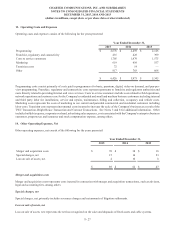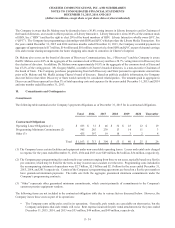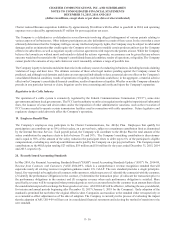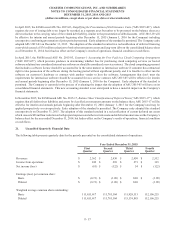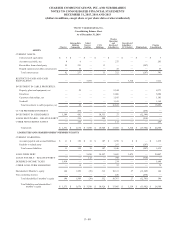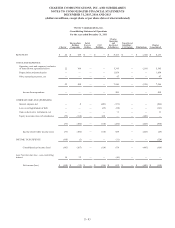Charter 2015 Annual Report Download - page 133
Download and view the complete annual report
Please find page 133 of the 2015 Charter annual report below. You can navigate through the pages in the report by either clicking on the pages listed below, or by using the keyword search tool below to find specific information within the annual report.CHARTER COMMUNICATIONS, INC. AND SUBSIDIARIES
NOTES TO CONSOLIDATED FINANCIAL STATEMENTS
DECEMBER 31, 2015, 2014 AND 2013
(dollars in millions, except share or per share data or where indicated)
F- 36
Charter reduced Bresnan acquisition liabilities by approximately $8 million with the offset to goodwill in 2014, and operating
expenses were reduced by approximately $3 million for post-acquisition tax years.
The Company is a defendant or co-defendant in several lawsuits involving alleged infringement of various patents relating to
various aspects of its businesses. Other industry participants are also defendants in certain of these cases. In the event that a court
ultimately determines that the Company infringes on any intellectual property rights, the Company may be subject to substantial
damages and/or an injunction that could require the Company or its vendors to modify certain products and services the Company
offers to its subscribers, as well as negotiate royalty or license agreements with respect to the patents at issue. While the Company
believes the lawsuits are without merit and intends to defend the actions vigorously, no assurance can be given that any adverse
outcome would not be material to the Company's consolidated financial condition, results of operations, or liquidity. The Company
cannot predict the outcome of any such claims nor can it reasonably estimate a range of possible loss.
The Company is party to lawsuits and claims that arise in the ordinary course of conducting its business, including lawsuits claiming
violation of wage and hour laws. The ultimate outcome of these other legal matters pending against the Company cannot be
predicted, and although such lawsuits and claims are not expected individually to have a material adverse effect on the Company’s
consolidated financial condition, results of operations or liquidity, such lawsuits could have, in the aggregate, a material adverse
effect on the Company’s consolidated financial condition, results of operations or liquidity. Whether or not the Company ultimately
prevails in any particular lawsuit or claim, litigation can be time consuming and costly and injure the Company's reputation.
Regulation in the Cable Industry
The operation of a cable system is extensively regulated by the Federal Communications Commission (“FCC”), some state
governments and most local governments. The FCC has the authority to enforce its regulations through the imposition of substantial
fines, the issuance of cease and desist orders and/or the imposition of other administrative sanctions, such as the revocation of
FCC licenses needed to operate certain transmission facilities used in connection with cable operations. Future legislative and
regulatory changes could adversely affect the Company’s operations.
19. Employee Benefit Plan
The Company’s employees may participate in the Charter Communications, Inc. 401(k) Plan. Employees that qualify for
participation can contribute up to 50% of their salary, on a pre-tax basis, subject to a maximum contribution limit as determined
by the Internal Revenue Service. Each payroll period, the Company will contribute to the 401(k) Plan the total amount of the
salary contribution the employee elects to defer between 1% and 50%. The Company’s matching contribution is discretionary
and is equal to 50% of the amount of the salary reduction the participant elects to defer (up to 6% of the participant’s eligible
compensation), excluding any catch-up contributions and is paid by the Company on a per pay period basis. The Company made
contributions to the 401(k) plan totaling $23 million, $19 million and $16 million for the years ended December 31, 2015, 2014
and 2013, respectively.
20. Recently Issued Accounting Standards
In May 2014, the Financial Accounting Standards Board ("FASB") issued Accounting Standards Update ("ASU") No. 2014-09,
Revenue from Contracts with Customers ("ASU 2014-09"), which is a comprehensive revenue recognition standard that will
supersede nearly all existing revenue recognition guidance under U.S. GAAP. The new standard provides a single principles-
based, five-step model to be applied to all contracts with customers, which steps are to (1) identify the contract(s) with the customer,
(2) identify the performance obligations in the contract, (3) determine the transaction price, (4) allocate the transaction price to
the performance obligations in the contract and (5) recognize revenue when each performance obligation is satisfied. More
specifically, revenue will be recognized when promised goods or services are transferred to the customer in an amount that reflects
the consideration expected in exchange for those goods or services. ASU 2014-09 will be effective, reflecting the one-year deferral,
for interim and annual periods beginning after December 15, 2017 (January 1, 2018 for the Company). Early adoption of the
standard is permitted but not before the original effective date. Companies can transition to the standard either retrospectively or
as a cumulative-effect adjustment as of the date of adoption. The Company is currently in the process of evaluating the impact
that the adoption of ASU 2014-09 will have on its consolidated financial statements and selecting the method of transition to the
new standard.



